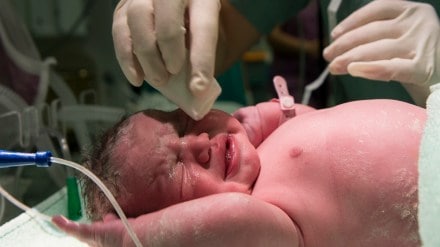A 31-week-old premature baby boy with bilateral congenital cataracts recently regained his vision after a complex-high risk surgery. The infant’s low birth weight of 1.05 kg increased the complexity and required specialized surgical approach.
Top ophthalmologist Dr. Sri Ganesh, who is also the Chairman and Managing Director of Nethradhama, successfully completed the complex bilateral cataract surgery on the boy.
The surgery was performed using advanced micro-incision techniques which involved removing the cataracts, followed by the implantation of foldable lenses. The complex case highlights, why early diagnosis, timely intervention, and comprehensive eye care is crucial to address such ocular abnormalities among infants.
Moreover, there has been some concern recently about the potential rise in infantile cases. According to Dr. Sri Ganesh, Chairman & Managing Director, Nethradhama Super Speciality, Eye Hospital, Bangalore, this could be attributed to the lack of awareness and access to healthcare services which exacerbates the situation, leading to delayed diagnosis and treatment.
Cataracts are estimated to be present in approximately 1 to 15/10,000 children worldwide, accounting for 5 percent–20 percent of childhood blindness. Globally, about 200,000 children are blind from bilateral cataracts worldwide, as per American Academy of Ophthalmology.
“As the nation strives to improve its healthcare infrastructure and educational outreach, understanding the underlying causes of childhood cataracts becomes essential for developing effective prevention and treatment strategies. It is also linked with the higher prevalence of maternal infections due to inadequate vaccination or healthcare access,” Dr. Ganesh said.
Regions with limited access to prenatal care, higher rates of maternal infections, or poor nutrition tend to show higher prevalence. Rural areas and socio-economically disadvantaged groups are often more affected by infantile cataracts, he said.
According to Dr. Ganesh, maternal infections, poor nutrition, diabetes, or substance use during pregnancy can increase the risk of cataracts in newborns. “Certain infections such as toxoplasmosis and rubella can travel through the placenta and reach the foetus, hence proper care should be taken in the antenatal period,” he said.
What are the common causes of cataracts in infants?
Cataracts in infants are often caused by genetic factors or inherited disorders. “It could also develop in children due to infections during pregnancy, such as rubella, toxoplasmosis, or syphilis. Metabolic disorders like galactosemia or trauma during or after birth, could also lead to the formation of childhood cataracts. Other causes include systemic syndromes like Down Syndrome,” Dr. Ganesh told Financial Express.com.
What are the early signs or symptoms of cataracts in infants that parents should look out for?
Parents should watch out for:
- A white or cloudy appearance in the pupil.
- Lack of visual responsiveness or failure to follow objects.
- Squinting or misaligned eyes (strabismus).
- Difficulty in recognizing faces or tracking light sources.
At what age are cataracts in infants usually diagnosed?
Cataracts can be diagnosed at birth during routine neonatal exams or during the first few months, if symptoms are observed. Some cases may be detected later if the screening is not performed earlier.
“Routine screening tests such as the red reflex examination are highly effective in early detection. This is especially important in cases of preterm delivery, significant antenatal history such as a history of fever with rash in the mother and even significant family history. These tests are typically done by ophthalmologists, but neonatologists and pediatricians also conduct them,” Dr. Ganesh said.
Role of Vitamin A
Vitamin A is vital for maintaining the integrity of epithelial tissues, including those in the cornea and lens. It also supports the production of rhodopsin which is critical for vision. Additionally, it acts as an antioxidant which helps protect the lens from oxidative damage.
Dr. Ganesh revealed that severe Vitamin A deficiency during pregnancy can disrupt the normal lens development and increase the risk of cataracts. “While cataracts are less directly linked to Vitamin A deficiency compared to corneal diseases (Xerophthalmia), malnutrition involving Vitamin A can indirectly impair eye development,” he said.
What are the current treatment options for cataracts in infants?
Cataracts in infants are treated primarily through surgical intervention, as there are no medications or non-surgical options to reverse lens opacity. Surgical removal of the cataract is followed by either the implantation of intraocular lenses (IOLs) or use of contact lenses post-surgery and a secondary intraocular lens fixation later in life.
Additionally, these patients will require visual rehabilitation and regular follow-ups, he said.
What preventive measures can expectant mothers take to reduce the risk of cataracts in their infants?
While not all causes of infant cataracts are preventable like in case of genetic predispositions, many risks can be significantly reduced with proactive steps taken before and during pregnancy.
- Vaccination against infections like rubella, influenza and chickenpox before pregnancy will help mitigate the complications during pregnancy.
- Adequate prenatal care and regular screenings are vital for early detection and treatment.
- Maintaining a balanced diet rich in essential vitamins and minerals such as folic acid, iron and zinc is also important, as well as regularly taking prenatal medication.
- General measures such as avoiding smoking, alcohol, and exposure to harmful toxins also play a major role.
“Raising awareness about early screening, maternal health, and accessible treatment options is crucial in addressing infant cataracts. Collaborations between healthcare providers, NGOs, and policymakers can help reduce the burden of this condition in rural and remote areas,” Dr. Ganesh told Financial Express.com.
